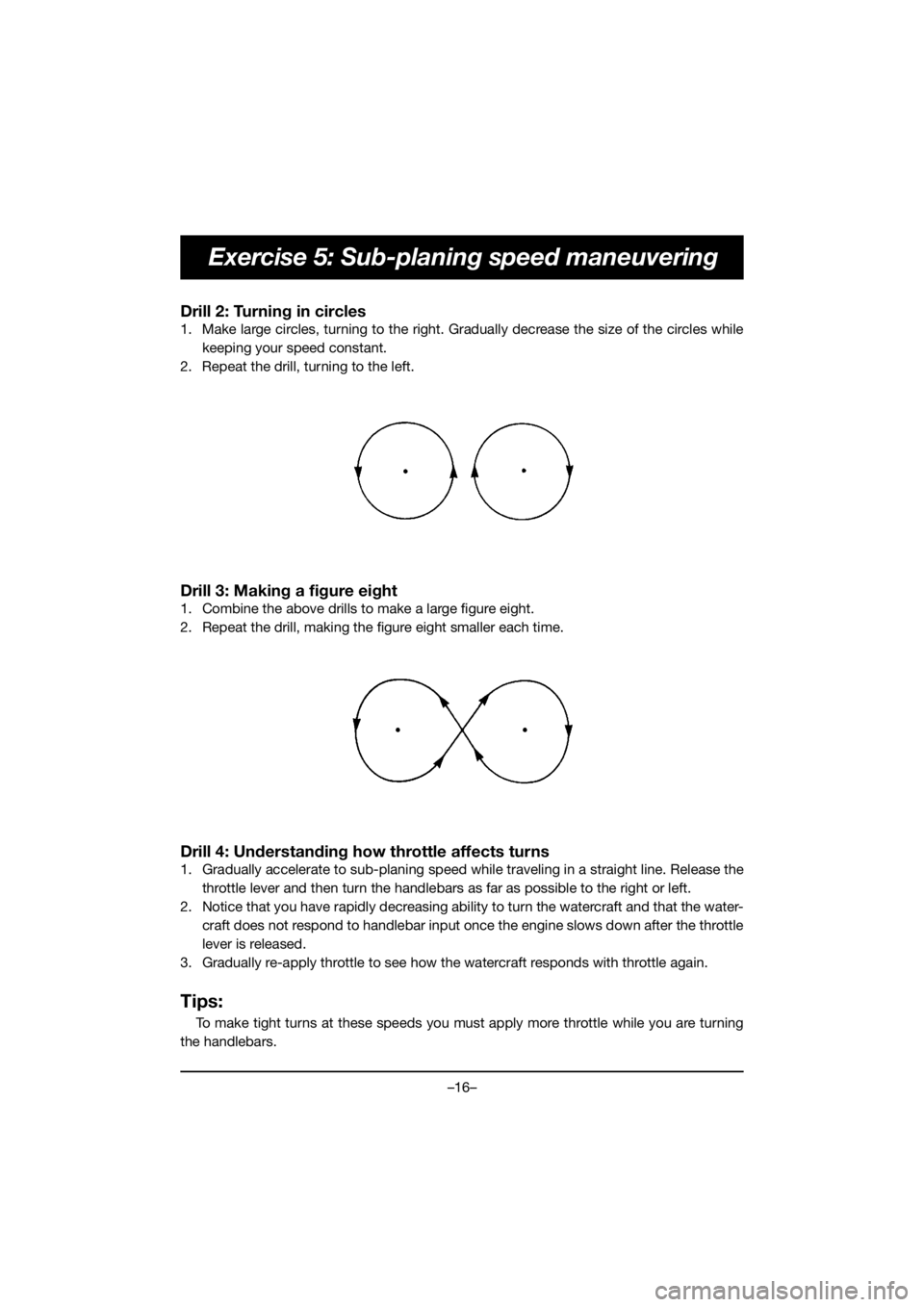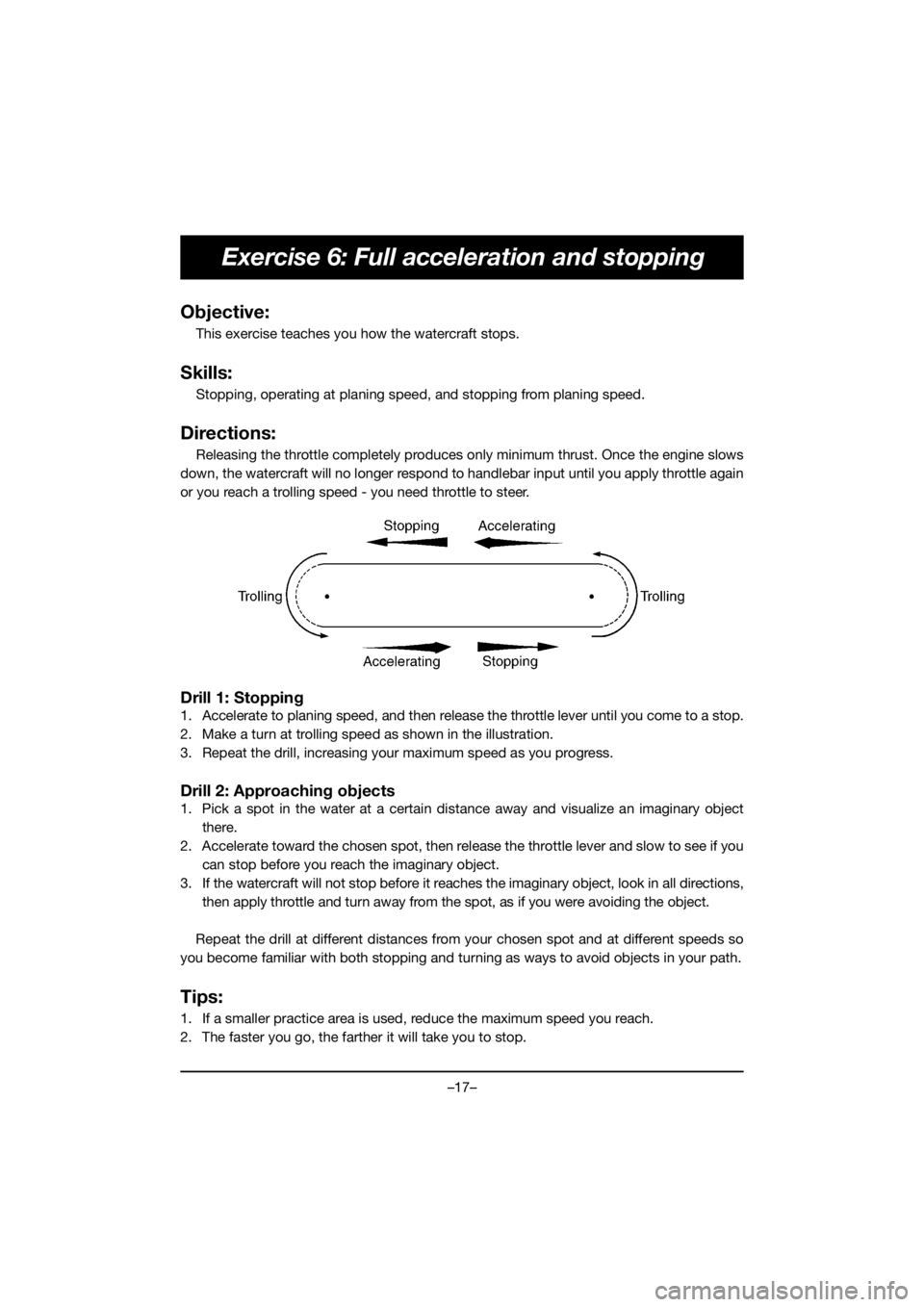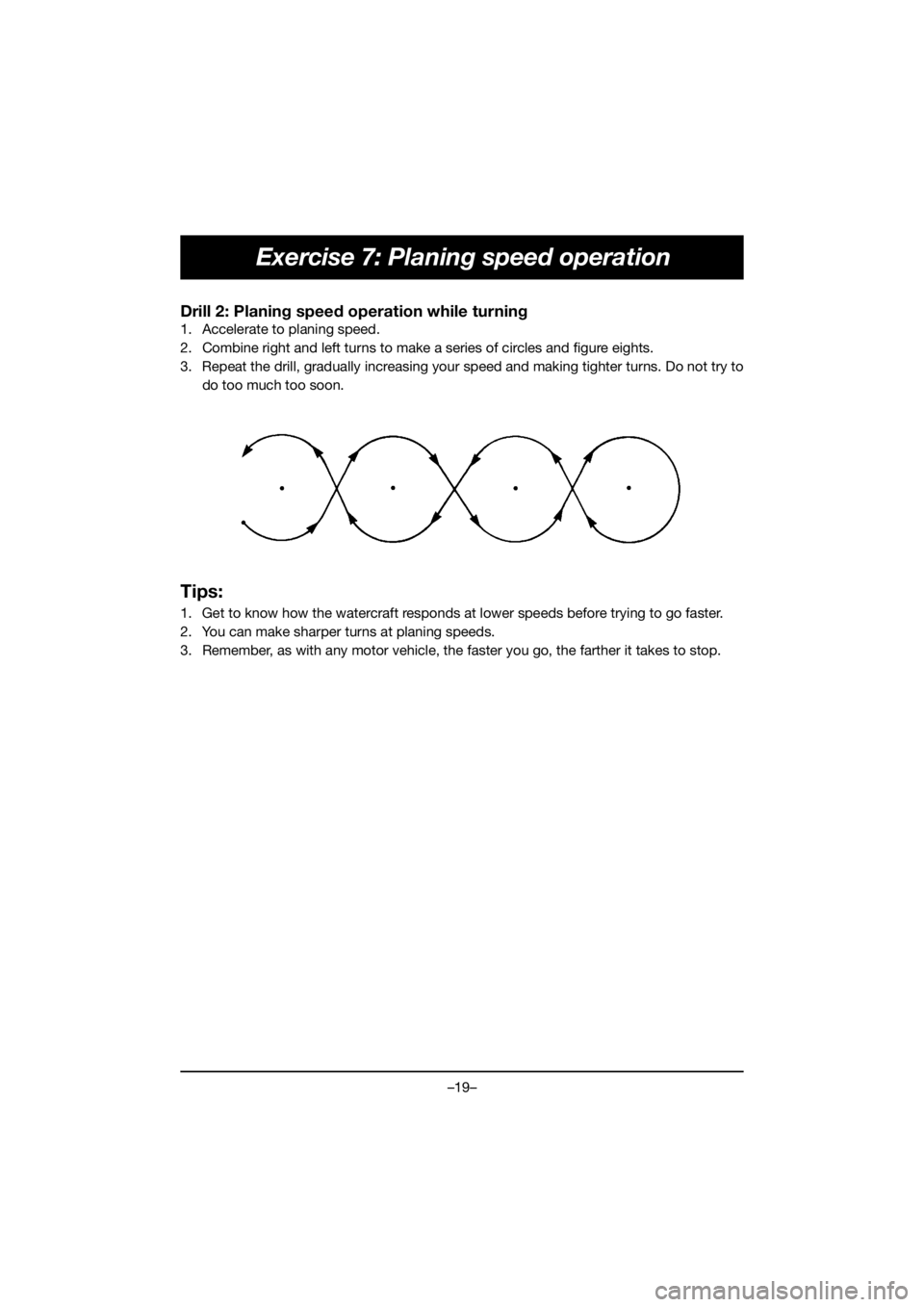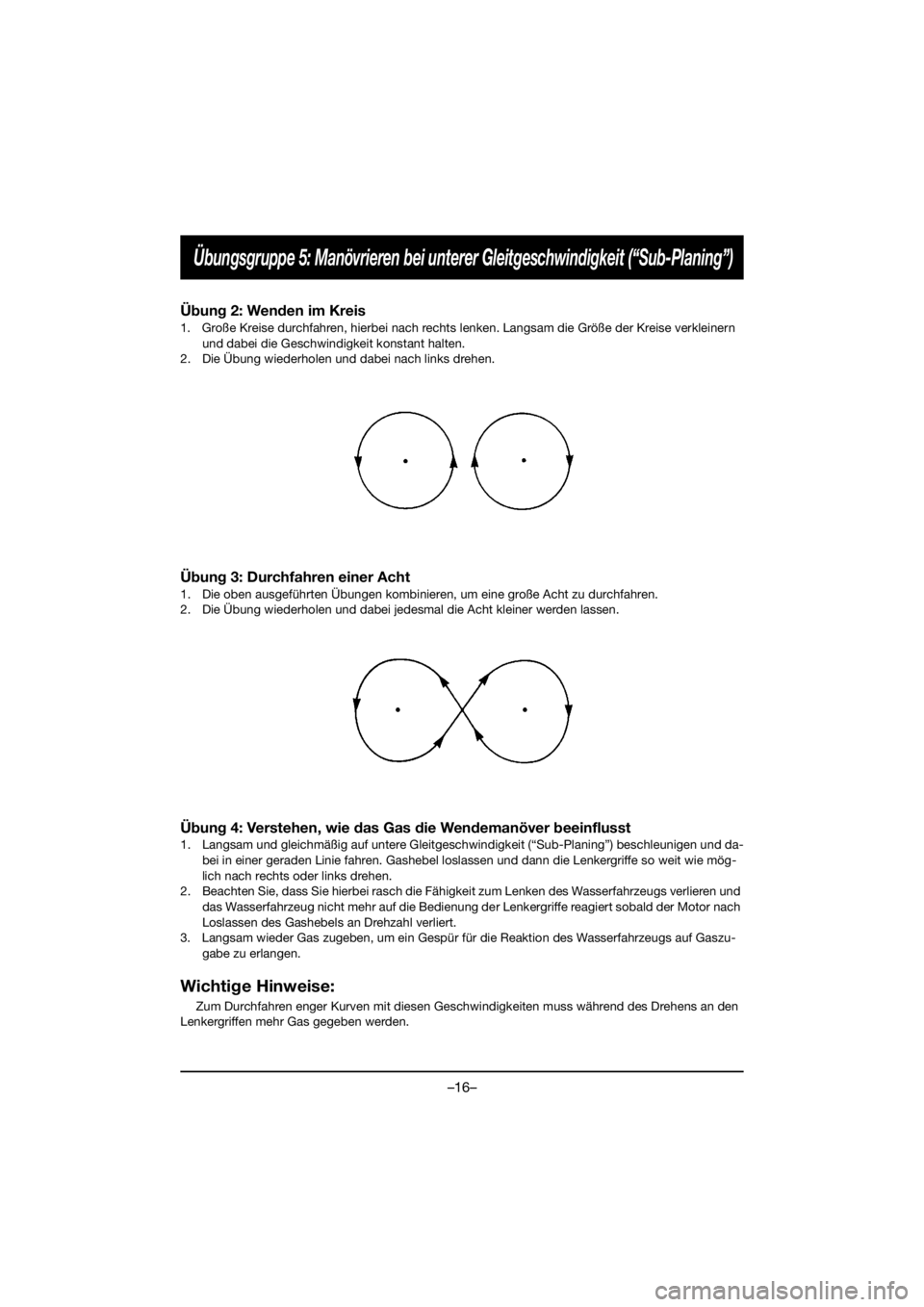ESP YAMAHA EX DELUXE 2020 Owners Manual
[x] Cancel search | Manufacturer: YAMAHA, Model Year: 2020, Model line: EX DELUXE, Model: YAMAHA EX DELUXE 2020Pages: 198, PDF Size: 5.03 MB
Page 3 of 198

INDEX
ENGLISHE
FRANÇAISF
DEUTSCHD
ESPAÑOLES
PORTUGUÊSP
ΕΛΛΗΝΙΚΑGR
ITALIANOI
SVENSKAS
E_F3Y-72-forPrint.book Page 1 Friday, June 7, 2019 1:58 PM
Page 6 of 198

–1–
Introduction
Yamaha watercraft are exciting ways to enjoy water recreation.
A watercraft can offer hours of fun, and it is tempting just to put yours in the water and
go.
But it is important to remember that, as with any new sport or any unfamiliar vehicle,
there are techniques that must be learned and skills that must be developed, both for max-
imum enjoyment and for safety.
This Riding Practice Guide booklet has been developed to help the new watercraft oper-
ator learn techniques and develop skills.
Everyone who intends to operate or ride as a passenger on a watercraft could benefit
from reading and using this handbook.
Keep in mind, though, that this practice guide is just that: a guide.
It does not take the place of common sense or good judgment.
Safe and responsible watercraft operation requires skills and knowledge that are learned
as riders become familiar with the craft.
Yamaha recommends that you practice each exercise in order according to the direc-
tions. Do not push yourself. Take a break when you get tired.
Be sure you fully understand how to perform each of the exercises well before you go on
to learn the next one, because skills learned in one lesson may be required in the next.
Remember, you must be the final judge of when you feel comfortable and competent
with the particular skills learned.
E_F3Y-72-forPrint.book Page 1 Friday, June 7, 2019 1:58 PM
Page 18 of 198

–13–
Exercise 4: Trolling speed maneuvering
Objective:
This exercise familiarizes you with the watercraft’s handling characteristics at trolling
speed. It teaches techniques you will use when beaching, docking, or approaching
objects.
Skills:
Starting and turning at trolling speed.
Directions:
Drill 1: Moving straight and turning at trolling speed
1. Board the watercraft, and check for people, objects and other watercraft.
2. Start the engine and go straight ahead.
3. Begin to turn, making a large figure eight about 15–21 m (50–70 ft) long. Do not apply
throttle.
Drill 2: Making full-lock turns at trolling speed
1. Turn the handlebars as far as possible in either direction. Allow the watercraft to turn
360°.
2. Practice turning both clockwise and counterclockwise to get a feel for how the water-
craft responds to handlebar movement.
E_F3Y-72-forPrint.book Page 13 Friday, June 7, 2019 1:58 PM
Page 21 of 198

–16–
Exercise 5: Sub-planing speed maneuvering
Drill 2: Turning in circles
1. Make large circles, turning to the right. Gradually decrease the size of the circles while
keeping your speed constant.
2. Repeat the drill, turning to the left.
Drill 3: Making a figure eight
1. Combine the above drills to make a large figure eight.
2. Repeat the drill, making the figure eight smaller each time.
Drill 4: Understanding how throttle affects turns
1. Gradually accelerate to sub-planing speed while traveling in a straight line. Release the
throttle lever and then turn the handlebars as far as possible to the right or left.
2. Notice that you have rapidly decreasing ability to turn the watercraft and that the water-
craft does not respond to handlebar input once the engine slows down after the throttle
lever is released.
3. Gradually re-apply throttle to see how the watercraft responds with throttle again.
Tips:
To make tight turns at these speeds you must apply more throttle while you are turning
the handlebars.
E_F3Y-72-forPrint.book Page 16 Friday, June 7, 2019 1:58 PM
Page 22 of 198

–17–
Exercise 6: Full acceleration and stopping
Objective:
This exercise teaches you how the watercraft stops.
Skills:
Stopping, operating at planing speed, and stopping from planing speed.
Directions:
Releasing the throttle completely produces only minimum thrust. Once the engine slows
down, the watercraft will no longer respond to handlebar input until you apply throttle again
or you reach a trolling speed - you need throttle to steer.
Drill 1: Stopping
1. Accelerate to planing speed, and then release the throttle lever until you come to a stop.
2. Make a turn at trolling speed as shown in the illustration.
3. Repeat the drill, increasing your maximum speed as you progress.
Drill 2: Approaching objects
1. Pick a spot in the water at a certain distance away and visualize an imaginary object
there.
2. Accelerate toward the chosen spot, then release the throttle lever and slow to see if you
can stop before you reach the imaginary object.
3. If the watercraft will not stop before it reaches the imaginary object, look in all directions,
then apply throttle and turn away from the spot, as if you were avoiding the object.
Repeat the drill at different distances from your chosen spot and at different speeds so
you become familiar with both stopping and turning as ways to avoid objects in your path.
Tips:
1. If a smaller practice area is used, reduce the maximum speed you reach.
2. The faster you go, the farther it will take you to stop.
E_F3Y-72-forPrint.book Page 17 Friday, June 7, 2019 1:58 PM
Page 24 of 198

–19–
Exercise 7: Planing speed operation
Drill 2: Planing speed operation while turning
1. Accelerate to planing speed.
2. Combine right and left turns to make a series of circles and figure eights.
3. Repeat the drill, gradually increasing your speed and making tighter turns. Do not try to
do too much too soon.
Tips:
1. Get to know how the watercraft responds at lower speeds before trying to go faster.
2. You can make sharper turns at planing speeds.
3. Remember, as with any motor vehicle, the faster you go, the farther it takes to stop.
E_F3Y-72-forPrint.book Page 19 Friday, June 7, 2019 1:58 PM
Page 30 of 198

–1–
Introduction
Un scooter nautique Yamaha est une manière passionnante de profiter de loisirs nau-
tiques.
Un scooter nautique peut offrir des heures de plaisir et vous êtes sûrement tenté de
mettre le vôtre immédiatement à l’eau et de partir.
Mais il est important de se rappeler que, comme pour tout sport ou avec tout véhicule
non familier, il y a des techniques à apprendre et des compétences à développer, tant pour
en tirer un maximum de plaisir que pour garantir la sécurité.
Ce Guide de pilotage a été conçu pour aider les nouveaux pilotes de scooter nautique à
apprendre les techniques et à développer les compétences requises.
Il est conseillé à toute personne qui envisage de piloter ce scooter nautique ou de navi-
guer comme passager de lire et d’utiliser ce guide.
N’oubliez pas toutefois que ce guide n’est que cela: un guide.
Il ne remplace pas le bon sens ni un jugement sain.
L’utilisation sûre et responsable d’un scooter nautique requiert des compétences et une
connaissance qui ne s’acquièrent qu’au fur et à mesure de la familiarisation des utilisateurs
avec leur véhicule.
Yamaha vous recommande de pratiquer chaque exercice dans l’ordre, en suivant les
instructions fournies. Ne forcez pas. Faites une pause lorsque vous êtes fatigué.
Soyez sûr de pouvoir pratiquer parfaitement chaque exercice avant de passer au sui-
vant, parce que les compétences acquises dans une leçon peuvent être nécessaires dans
la suivante.
Souvenez-vous: vous devez être le juge final du moment auquel vous vous sentez à
l’aise et parfaitement maître des compétences acquises.
E_F3Y-72-forPrint.book Page 1 Friday, June 7, 2019 1:58 PM
Page 32 of 198

–3–
Information importante
Ne relâchez pas la manette des gaz lorsque vous essayez d’éviter des objets ;
comme avec d’autres bateaux à moteur, vous avez besoin de propulsion pour pou-
voir manœuvrer. Vérifiez toujours la commande des gaz et la direction avant de dé-
marrer le VNI.
Respectez toutes les règles de navigation et les règlements locaux applicables aux
VNI. Reportez-vous au Manuel de l’utilisateur pour de plus amples informations.
@
E_F3Y-72-forPrint.book Page 3 Friday, June 7, 2019 1:58 PM
Page 55 of 198

–2–
Wichtige Informationen
Diese Anleitung zu Fahrübungen ist kein Ersatz für die Betriebsanleitung oder die Warnpla-
ketten Ihres Wasserfahrzeugs.
Studieren Sie unbedingt diese anderen Anleitungen gründlich, bevor Sie das Wasserfahrzeug
überhaupt erstmalig in Betrieb nehmen.
Kollisionen führen zu mehr Verletzungen und tödlichen Unfällen, als jeder andere Unfall mit Pri-
vatwasserfahrzeugen (PWC).
Zur Vermeidung von Kollisionen:
Suchen Sie mit scharfem Blick ständig Ihr gesamtes Umfeld auf Personen, Gegenstände oder
andere Wasserfahrzeuge ab. Achten Sie besonders auf Umstände, die Ihre Sicht einschränken
oder Sie daran hindern, andere zu sehen.
Fahren Sie defensiv und mit angemessener Geschwindigkeit, und wahren Sie einen Sicherheits-
abstand zu Personen, Gegenständen und anderen Wasserfahrzeugen.
●Folgen Sie nicht direkt im Fahrwasser hinter Privatwasserfahrzeugen oder anderen Booten.●Nähern Sie sich nicht anderen, um sie mit Wasser zu besprühen oder zu bespritzen, nähern
Sie sich anderen Booten nicht zu sehr und fahren Sie nicht zu schnell für die vorherrschen-
den Bedingungen.
●Meiden Sie Orte mit versunkenen Hindernissen und seichte Gewässer.
●EX / EX Sport: Vermeiden Sie scharfe Wendungen oder andere Manöver, die es anderen er-
schweren, Ihnen auszuweichen oder Ihren Kurs zu erkennen.
●EX Deluxe: Vermeiden Sie scharfe Wendungen, schnelles Abbremsen durch starkes Drücken
des Reverse with Intuitive Deceleration Electronics-(RiDE-)Hebels oder andere Manöver, die
es anderen erschweren, Ihnen auszuweichen oder Ihren Kurs zu erkennen.
Das RiDE-System ist ein elektronisches System zur Kontrolle der Motordrehzahl und der Um-
kehrklappe, die sich in der Nähe der Jetdüse befindet. Mit dem RiDE-Hebel, der sich am lin-
ken Lenkergriff befindet, kann die Richtung des Schubs geändert werden, sodass sich das
Wasserfahrzeug rückwärts bewegt oder in Neutralstellung bleibt. Das RiDE-System unter-
stützt den Fahrer beim Abbremsen und bei Niedergeschwindigkeits-Manövern wie dem Zu-
wasserlassen, Anlanden und Anlegen.
Handeln Sie rasch, um Zusammenstöße zu vermeiden. Bedenken Sie jederzeit, dass Wasser-
fahrzeuge und Boote keine Bremsen haben.
EX Deluxe: Das RiDE-System ist keine Bremsvorrichtung, um gefährliche Situationen zu vermei-
den.
E_F3Y-72-forPrint.book Page 2 Friday, June 7, 2019 1:58 PM
Page 69 of 198

–16–
Übungsgruppe 5: Manövrieren bei unterer Gleitgeschwindigkeit (“Sub-Planing”)
Übung 2: Wenden im Kreis
1. Große Kreise durchfahren, hierbei nach rechts lenken. Langsam die Größe der Kreise verkleinern
und dabei die Geschwindigkeit konstant halten.
2. Die Übung wiederholen und dabei nach links drehen.
Übung 3: Durchfahren einer Acht
1. Die oben ausgeführten Übungen kombinieren, um eine große Acht zu durchfahren.
2. Die Übung wiederholen und dabei jedesmal die Acht kleiner werden lassen.
Übung 4: Verstehen, wie das Gas die Wendemanöver beeinflusst
1. Langsam und gleichmäßig auf untere Gleitgeschwindigkeit (“Sub-Planing”) beschleunigen und da-
bei in einer geraden Linie fahren. Gashebel loslassen und dann die Lenkergriffe so weit wie mög-
lich nach rechts oder links drehen.
2. Beachten Sie, dass Sie hierbei rasch die Fähigkeit zum Lenken des Wasserfahrzeugs verlieren und
das Wasserfahrzeug nicht mehr auf die Bedienung der Lenkergriffe reagiert sobald der Motor nach
Loslassen des Gashebels an Drehzahl verliert.
3. Langsam wieder Gas zugeben, um ein Gespür für die Reaktion des Wasserfahrzeugs auf Gaszu-
gabe zu erlangen.
Wichtige Hinweise:
Zum Durchfahren enger Kurven mit diesen Geschwindigkeiten muss während des Drehens an den
Lenkergriffen mehr Gas gegeben werden.
E_F3Y-72-forPrint.book Page 16 Friday, June 7, 2019 1:58 PM